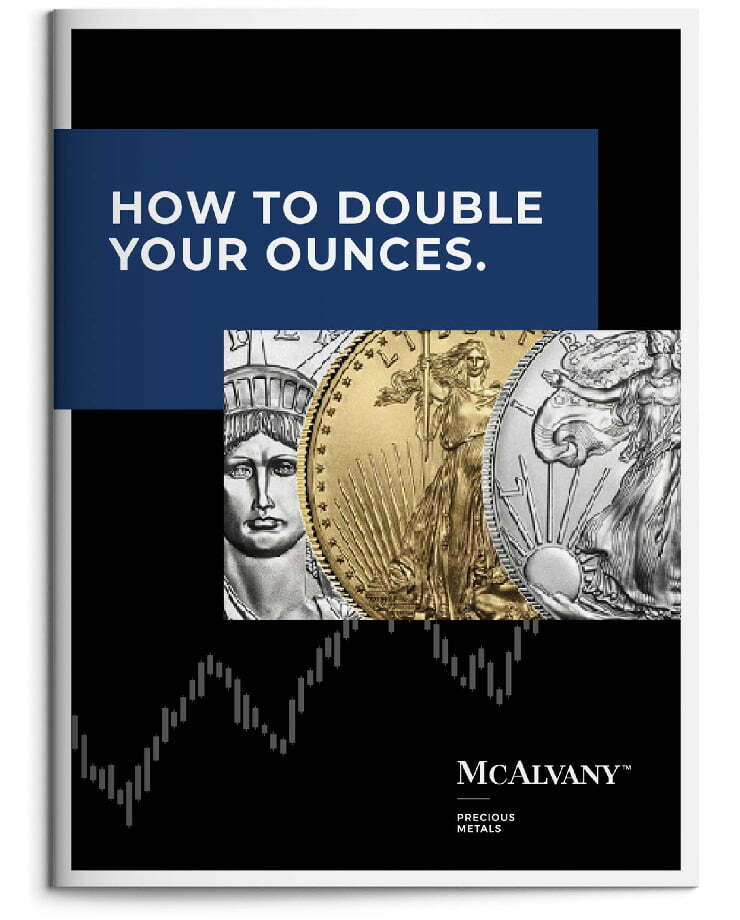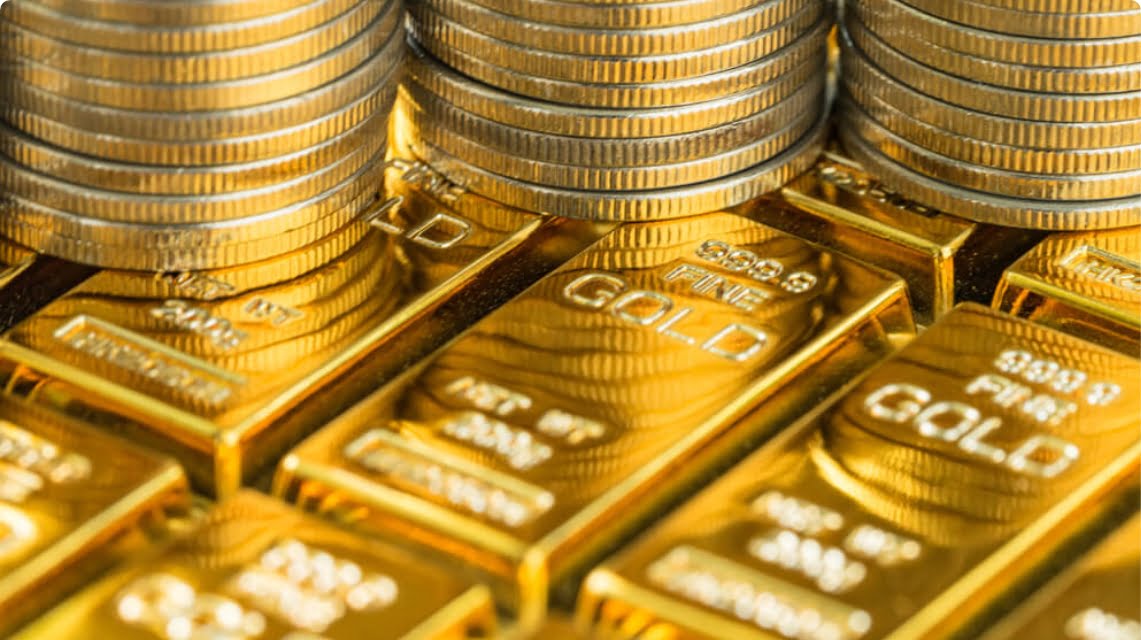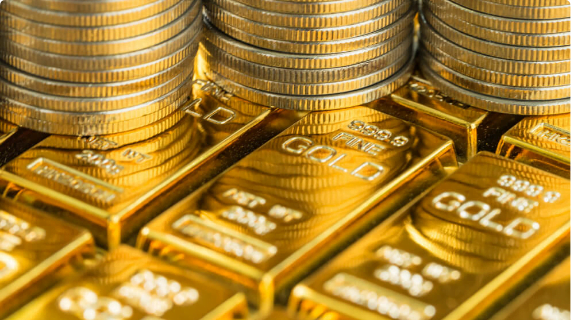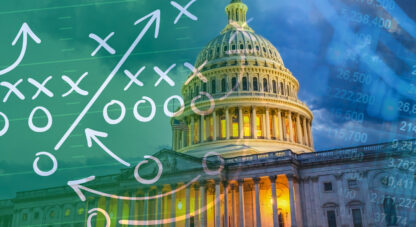Enjoy the Show
While the last month and a half has delivered a seemingly endless parade of new all-time highs from the major stock market indexes, the underlying momentum of this ongoing rally continues to falter. Despite the blistering rally, the percentage of NASDAQ 100 stocks trading above their 50-day moving averages peaked back in June at over 85%. As of this week, that number is down to only about 50%. In other words, the booming market rally is, at this point, more façade than reality, and is increasingly the product of a very concentrated handful of primarily high-profile, mega-cap tech stocks. In HAI‘s view, a rapidly narrowing rally in which 50% of index components can’t even hold their 50-day moving average is good reason for caution.
That weakening performance breadth for the major indexes, however, is in stark contrast to the precious metals equities. For both the precious metals producers and royalty and streaming companies, trading over the 50-day moving average is now the overwhelming norm. In fact, this week, despite the fact that underlying physical gold and silver prices were down, the gold and silver equities pushed to a new post-pandemic weekly closing high. Quite a feat. In HAI‘s view, booming free-cash-flows in the precious metals sector are fueling the long-anticipated, newly rekindled interest from Western investors. And with expectations for a renewed breakout higher in both the monetary metals over the coming weeks and months, HAI expects the upside momentum in precious metals equities to continue.
On this relatively slow August week on Wall Street, let’s take a moment to appreciate some important history. On August 15, 1971—54 years ago as of today—U.S. President Richard Nixon radically changed the course of monetary history when he closed the gold window and ended the convertibility of U.S. dollars to gold.
On a Sunday night address to the nation, Nixon said, “I have directed Secretary Connally to suspend, temporarily, the convertibility of the dollar into gold or other reserve assets except in amounts and conditions determined to be in the interest of monetary stability and in the best interests of the United States.”
Much of what is discussed in HAI week-in and week-out can be traced back to that jaw-dropping speech 54 years ago that cut the ties between paper currency and real assets, and effectively marked the start of history’s most radical monetary experiment.
Nixon immediately followed his proclamation by explaining, “Now, what is this action—which is very technical—what does it mean for you? Let me lay to rest the bugaboo of what is called devaluation… Your dollar will be worth just as much tomorrow as it is today.”
Well, HAI deeply loves America, but, in this author’s view, that was not our leadership’s finest moment—nor have Nixon’s assurances aged even remotely well.
The severing of the tie between the dollar and gold was certainly not temporary, and the “bugaboo of what is called devaluation” was very much as real as rain.
In fact, though the dollar has already lost close to 90% of its purchasing power since ’71, we are now told that inflation (devaluation) targeted at 2% annually is an economic good to be sought after. Then, even after aiming to create 2% inflation, the governing body charged with limiting that devaluation to 2% has proceeded to overshoot its target for what are now 53 consecutive months, or four years and four months—all while claiming “substantial progress” on limiting the price pressure.
Unfortunately, however, the inflationary fire may be about to intensify.
Recently, HAI suggested that the Trump administration, by national security necessity, looks very likely to pursue policy prerogatives that prioritize addressing our most critical, long-ignored national vulnerabilities. Those critical priorities include the revitalization and reshoring of America’s severely atrophied manufacturing base and a significant reduction in the national debt-to-GDP ratio.
If this administration attempts meaningful progress on both fronts, there are several critical implications for investors. The U.S. dollar is likely to be considerably weakened, the yield curve is likely to be substantially suppressed, and the economy is likely to be run hot. That means some form of yield curve control while running industrial policy that features highly inflationary money printing to pay for the re-shoring and revitalization of our manufacturing base as the official sector buys commodities, properties, companies, and assets deemed critical to national security.
This week offered further evidence that we are, indeed, very much on that inflationary road. In an important New York Times op-ed, U.S. Trade Representative Jamieson Greer seemed to confirm some crucial tenets of the HAI thesis. Greer suggests that the world is moving on from the post-1971 global system, that the reindustrialization of America is critical, and that running a highly inflationary industrial policy (“a generational project to re-industrialize America”) is “required” to address critical American vulnerabilities.
As Greer put it, “Our current, nameless global order, which is dominated by the World Trade Organization and is notionally designed to pursue economic efficiency and regulate the trade policies of its 166 member countries, is untenable and unsustainable… The United States has paid for the system with the loss of industrial jobs and economic security, other countries have been unable to make needed reforms, and the biggest winner has been China, with its state-owned enterprises and five-year plans. Unsurprisingly, the past decade has seen significant international and bipartisan American frustration at the system’s failure to adapt to meet the essential interests of sovereign nations. Now, reform is at hand.”
Referring to what HAI has called the post-1971 dollar recycling system, Greer says, “Our trading partners were adept at this game, and elites on Wall Street and in Washington were all too happy to cash in on the global arbitrage by moving production abroad. The net result? The bulk of global manufacturing shifted to jurisdictions such as China…while the United States ran up what in absolute terms is the highest trade deficit in the history of the world. This led to extensive and well-documented losses in U.S. industrial capacity and employment as well as reliance on our adversaries for critical supply chains. We subordinated our country’s economic and national security imperatives to a lowest common denominator of global consensus.”
Greer continued, saying that, “What began at Bretton Woods as a necessary effort to rebuild a global trade system shattered by war evolved, over nine rounds of trade negotiations, into something unrecognizable… Reversing decades of harmful policy that weakened our manufacturing capacity and work force will take time and coordinated effort across the public and private sectors. But keeping the status quo would only accelerate the dangerous trajectory of deindustrialization. We require a generational project to re-industrialize America, and time is short.”
To HAI, Greer’s op-ed reads like confirmation that America is indeed intent on moving on from the post-1971 global system, that the reindustrialization of America is viewed as an absolutely vital necessity, and that running a highly inflationary industrial policy (“a generational project to re-industrialize America”) is “required” to address critical American vulnerabilities.
This week, a Department of Defense press release confirmed that the “Office of Strategic Capital announces first loan through DoD Agreement with MP Materials to secure critical materials.” The press release sure smells like the start of an inflationary bout of industrial policy. It reads, “The Office of Strategic Capital (OSC) announces the recent execution of its first direct loan to strengthen the U.S. industrial base and protect critical minerals supply chains. As part of a wider July 2025 agreement between DoD and MP Materials, owner and operator of a U.S. rare earths mine, OSC provided a $150 million loan to add heavy rare earth separation capabilities to MP Materials’ existing processing facility in Mountain Pass, California.”
Under-Secretary of Defense for Research and Engineering Emil Michael added that, “Through this loan, we are taking decisive action to restore our domestic critical minerals supply chain, revive our industrial base, and rebuild our military to achieve President Trump’s goal of peace through strength.”
To be sure, achieving that sort of “peace through strength” initiative costs money, and as the press release highlights, “The funding for OSC’s $150 million loan to MP Materials comes from the One Big Beautiful Bill Act, which President Trump signed into law on July 4, 2025. The bill provides OSC with $500 million of credit subsidy funding, creating up to $100 billion in available loan funds specifically for critical minerals production and related industries and projects.”
If the U.S. requires a “generational project to re-industrialize America, and time is short,” then we should expect more in the way of strategic government deals, much more money, and more inflation over the coming years.
In short, in HAI‘s view, a “generational project to re-industrialize America” should essentially be interpreted as a generational opportunity for investors to own gold and related assets. In this environment, a no-counterparty risk neutral reserve asset that’s been the world’s proven store of value for 5,000 years has never looked so good.
Gold, gold miners, and silver are already shining. But with this administration’s increasingly clear policy trajectory towards radical and inflationary solutions to America’s massive and unavoidable problems, HAI suggests that the precious metals complex has ample upside room to run.
The Western investor is only just now entering the PM sector. Historically, with the Western investor engaged, precious metals bull markets become quite the spectacle. In other words, in HAI‘s view, it’s about time to sit back and enjoy the show.
Weekly performance: The S&P 500 was up 0.94%. Gold was down 1.86%, silver was off 0.92%, platinum gained 0.44%, and palladium was off 1.83%. The HUI gold miners index gained 0.70%. The IFRA iShares US Infrastructure ETF was up 1.00%. Energy commodities were volatile and lower on the week. WTI crude oil was off 1.16%, while natural gas was lower by 2.30%. The CRB Commodity Index was up 0.35%. Copper gained 0.18%. The Dow Jones US Specialty Real Estate Investment Trust Index was down 0.48%. The Vanguard Utilities ETF was off 0.57%. The dollar index was down 0.33% to close the week at 97.86. The yield on the 10-yr U.S. Treasury was up 3 bps to close the week at 4.32%.
Have a wonderful weekend!
Best Regards,
Morgan Lewis
Investment Strategist & Co-Portfolio Manager
MWM LLC















